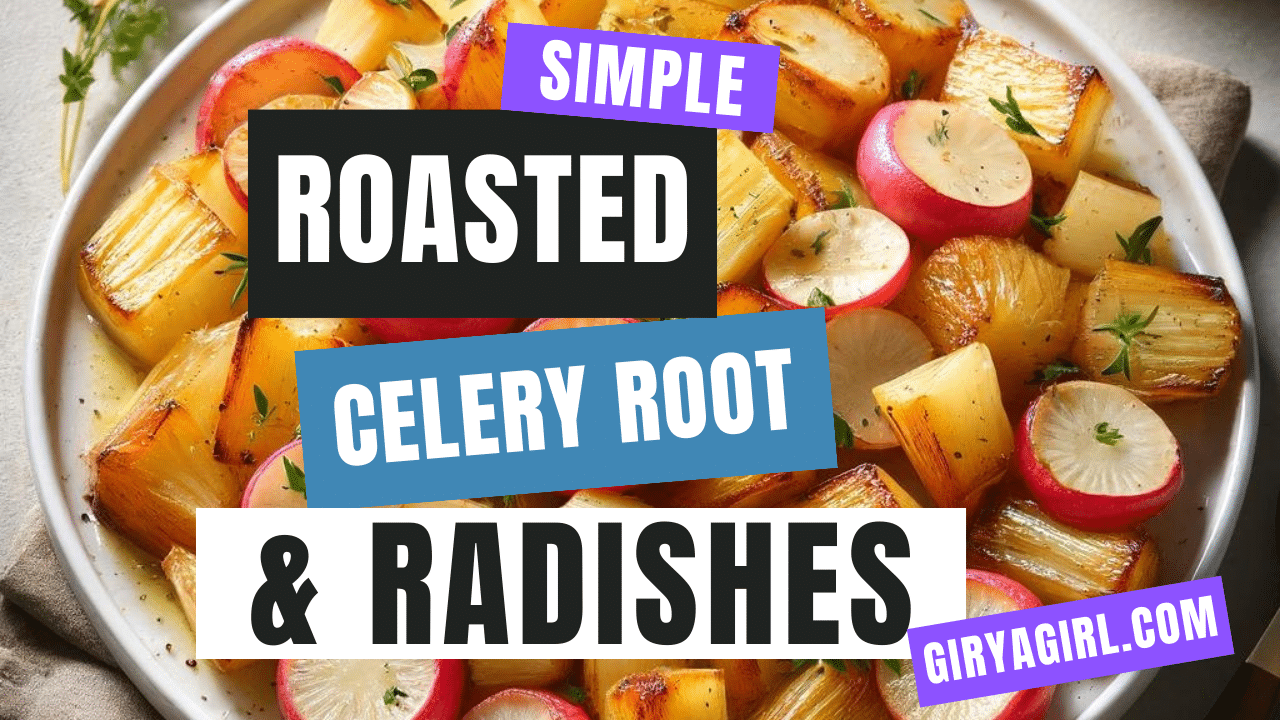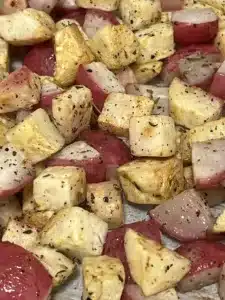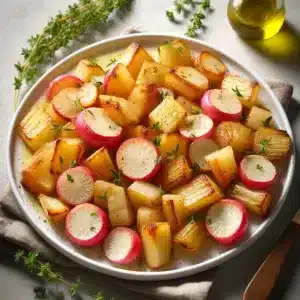
I’ve been a big fan of roast vegetables for a very long time (check out this vegetable roasting guide I shared back in 2011!), and they can be a sure bet as a side dish for any number of delicious meats too!
This recipe and post were made with assistance from my own, specially designed custom low carbs, whole foods recipe helper, Wholesome Low Carb Eats GPT! To try it yourself, click here – you will need a paid OpenAI account, but as an alternative if you have a recipe request, let me know and I can feature it in a future post! I have designed this GPT in a very special way, it will help you brainstorm low carb but whole foods focused recipes. So you won’t find weird chemical ingredients like artificial sweeteners that can be hard to digest. Let me know in the comments if you try it out!
Also note that if you think the veggies in the lead image look like they may have been grown in an “uncanny valley” you’re correct! Check out the difference between reality on the left and generated on the right! I’m a little heavy handed with the fresh cracked pepper apparently…
Roast Celery Root and Radishes
Here’s a simple and delicious recipe for roasting celery root and radishes on a half sheet pan. Celery root has a subtle, earthy taste, while radishes provide a hint of peppery taste that mellows out when roasted, offering a nice contrast.
Ingredients:
- 1 large celery root (celeriac), peeled and cut into 1/2-inch cubes
- 1 bunch of radishes, trimmed and halved (if large, they can be quartered)
- 2 tablespoons olive oil (or oil of your choice)
- Salt, to taste
- Freshly ground black pepper, to taste
- Optional: 2 cloves of garlic, minced
- Optional: Fresh herbs like thyme or parsley for garnish (bonus points if you grew them yourself – I grow thyme and parsley right in my home office – read about that now! Thyme and parsley do especially well in my Click and Grow Gardens!)
Instructions:
- Preheat your oven to 425°F (220°C), which is a perfect temperature for roasting vegetables and achieving a good caramelization.
- Prep the Vegetables: Peel the celery root and cut it into 1/2-inch cubes. Trim the radishes and cut them in halves or quarters, depending on size, to ensure that they are about the same size as the celery root pieces for even cooking.
- Season: In a large bowl, toss the celery root and radishes with olive oil, minced garlic (if using), and a generous pinch of salt and black pepper until they are well coated.
- Arrange: Spread the vegetables out on a half sheet pan in a single layer, giving them a bit of space to ensure they roast rather than steam.
- Roast: Place the sheet pan in the oven and roast for about 25-30 minutes, or until the vegetables are golden and fork-tender. Halfway through, stir the vegetables for even browning.
- Garnish and Serve: Once roasted, you can toss the vegetables with fresh thyme or parsley for added flavor. Adjust the seasoning with more salt and pepper if needed before serving.
This recipe will provide about 4 servings as a side dish. The celery root turns wonderfully tender with a slight sweetness when roasted, and the radishes become juicy and lose their sharp bite, complementing the celery root nicely.
Estimating Nutrition: Carbs, Fiber, Net Carbs…
To estimate the carbohydrate content per serving for roasted celery root and radishes, let’s look at the average carbohydrate values for each vegetable and divide by the number of servings (in this example, 4 servings):
- Celery Root (Celeriac): One medium celery root (about 1 pound or 454 grams) has approximately 42 grams of total carbohydrates, and about 9 grams of fiber, leaving 33 grams of net carbs.
- Radishes: A bunch of radishes (about 12 medium radishes or 200 grams) has roughly 4 grams of total carbohydrates, and nearly 2 grams of fiber, which results in about 2 grams of net carbs.
Assuming that the olive oil and seasonings contribute negligible carbohydrates, we can calculate the total net carbs for the recipe and then per serving:
Total net carbs for the recipe = 33 (celery root) +2 (radishes) =35 grams
Divided by four servings, each serving of roasted celery root and radishes would have approximately 9 grams of net carbohydrates. Please note that these are rough estimates, and actual values can vary based on the specific sizes and types of vegetables used! YMMV and all that good stuff.
Celery Root Tips and Tricks!

If you’re like me, you may have not really worked with celery root before , here’s some tips for working with this odd but interesting vegetable! Celery root, sometimes called celeriac, has a unique flavor and texture, and a strange exterior unlike most vegetables I’d worked with before. You may also have difficulty finding it, our local Whole Foods sometimes carries it, but sometimes not! Specialty and high end grocery stores are often the best bet. Worst case, if you can’t find it, roast radishes on their own are also delicious, and I’ve created a simple recipe for that which is on regular rotation!
- Choosing: Look for firm celery roots with a minimal amount of knobs and rootlets, which make them easier to peel.
- Storing: Keep it in the crisper drawer of your refrigerator. Celery root can last up to a couple of weeks if stored properly.
- Cleaning: Rinse the celery root under cold water to remove any soil or debris before you start peeling.
- Peeling: Its gnarled surface can’t be peeled with a vegetable peeler effectively. Instead, use a sharp chef’s knife to slice off the skin. Cut the top and bottom off to create a stable base and then work your knife down the sides to remove the skin.
- Preventing Browning: Celery root will start to brown once it’s cut, similar to apples. To prevent this, you can place the cut pieces in a bowl of water with a squeeze of lemon juice until you’re ready to cook them.
- Cooking: Celery root can be roasted, boiled, mashed, or made into a soup or puree. It has a texture similar to potatoes when cooked, so you can use it as a low-carb substitute in many potato dishes.
- Flavor Pairings: Its flavor, which is akin to a cross between celery and parsley, pairs well with other root vegetables, apples, and robust herbs like rosemary and thyme.
- Safety: Since celery root is hard and can roll, it’s important to cut it on a stable surface and to keep your fingers clear of the blade. Take your time and use deliberate, controlled cuts.
- Cooking Time: Depending on the size of your chunks and the method of cooking, celery root generally takes a bit longer to become tender than many other vegetables. It’s done when it can be easily pierced with a fork.
- Raw Use: It can also be eaten raw; grated celery root makes a fantastic addition to salads and slaws.








Leave a Reply